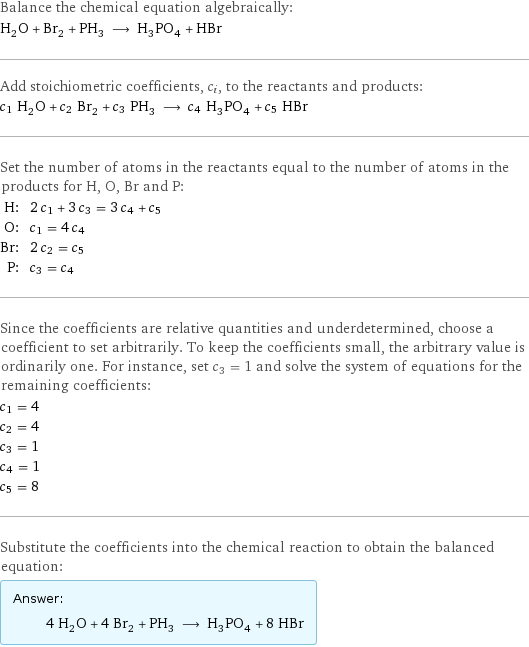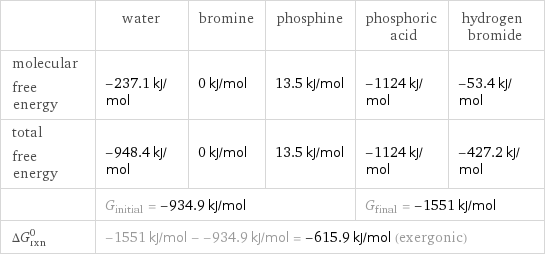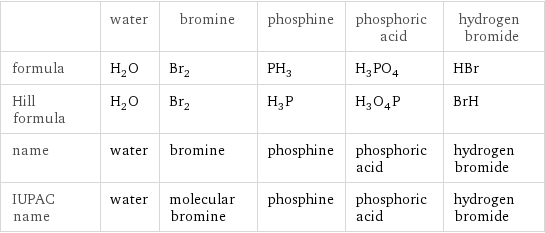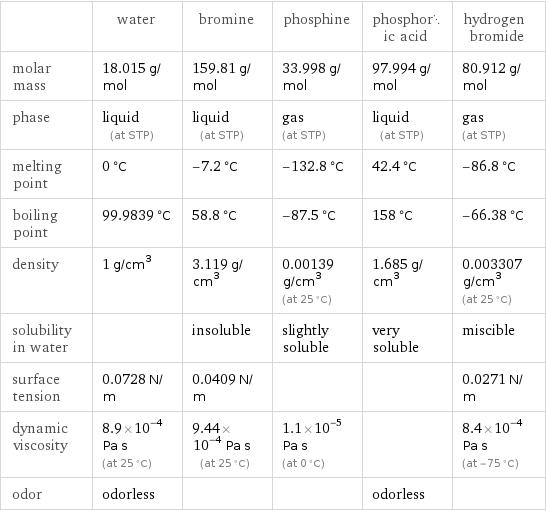Input interpretation

H_2O water + Br_2 bromine + PH_3 phosphine ⟶ H_3PO_4 phosphoric acid + HBr hydrogen bromide
Balanced equation

Balance the chemical equation algebraically: H_2O + Br_2 + PH_3 ⟶ H_3PO_4 + HBr Add stoichiometric coefficients, c_i, to the reactants and products: c_1 H_2O + c_2 Br_2 + c_3 PH_3 ⟶ c_4 H_3PO_4 + c_5 HBr Set the number of atoms in the reactants equal to the number of atoms in the products for H, O, Br and P: H: | 2 c_1 + 3 c_3 = 3 c_4 + c_5 O: | c_1 = 4 c_4 Br: | 2 c_2 = c_5 P: | c_3 = c_4 Since the coefficients are relative quantities and underdetermined, choose a coefficient to set arbitrarily. To keep the coefficients small, the arbitrary value is ordinarily one. For instance, set c_3 = 1 and solve the system of equations for the remaining coefficients: c_1 = 4 c_2 = 4 c_3 = 1 c_4 = 1 c_5 = 8 Substitute the coefficients into the chemical reaction to obtain the balanced equation: Answer: | | 4 H_2O + 4 Br_2 + PH_3 ⟶ H_3PO_4 + 8 HBr
Structures

+ + ⟶ +
Names

water + bromine + phosphine ⟶ phosphoric acid + hydrogen bromide
Reaction thermodynamics
Gibbs free energy

| water | bromine | phosphine | phosphoric acid | hydrogen bromide molecular free energy | -237.1 kJ/mol | 0 kJ/mol | 13.5 kJ/mol | -1124 kJ/mol | -53.4 kJ/mol total free energy | -948.4 kJ/mol | 0 kJ/mol | 13.5 kJ/mol | -1124 kJ/mol | -427.2 kJ/mol | G_initial = -934.9 kJ/mol | | | G_final = -1551 kJ/mol | ΔG_rxn^0 | -1551 kJ/mol - -934.9 kJ/mol = -615.9 kJ/mol (exergonic) | | | |
Equilibrium constant
![Construct the equilibrium constant, K, expression for: H_2O + Br_2 + PH_3 ⟶ H_3PO_4 + HBr Plan: • Balance the chemical equation. • Determine the stoichiometric numbers. • Assemble the activity expression for each chemical species. • Use the activity expressions to build the equilibrium constant expression. Write the balanced chemical equation: 4 H_2O + 4 Br_2 + PH_3 ⟶ H_3PO_4 + 8 HBr Assign stoichiometric numbers, ν_i, using the stoichiometric coefficients, c_i, from the balanced chemical equation in the following manner: ν_i = -c_i for reactants and ν_i = c_i for products: chemical species | c_i | ν_i H_2O | 4 | -4 Br_2 | 4 | -4 PH_3 | 1 | -1 H_3PO_4 | 1 | 1 HBr | 8 | 8 Assemble the activity expressions accounting for the state of matter and ν_i: chemical species | c_i | ν_i | activity expression H_2O | 4 | -4 | ([H2O])^(-4) Br_2 | 4 | -4 | ([Br2])^(-4) PH_3 | 1 | -1 | ([PH3])^(-1) H_3PO_4 | 1 | 1 | [H3PO4] HBr | 8 | 8 | ([HBr])^8 The equilibrium constant symbol in the concentration basis is: K_c Mulitply the activity expressions to arrive at the K_c expression: Answer: | | K_c = ([H2O])^(-4) ([Br2])^(-4) ([PH3])^(-1) [H3PO4] ([HBr])^8 = ([H3PO4] ([HBr])^8)/(([H2O])^4 ([Br2])^4 [PH3])](../image_source/e7bf503928d9201734b76804dc4ab67c.png)
Construct the equilibrium constant, K, expression for: H_2O + Br_2 + PH_3 ⟶ H_3PO_4 + HBr Plan: • Balance the chemical equation. • Determine the stoichiometric numbers. • Assemble the activity expression for each chemical species. • Use the activity expressions to build the equilibrium constant expression. Write the balanced chemical equation: 4 H_2O + 4 Br_2 + PH_3 ⟶ H_3PO_4 + 8 HBr Assign stoichiometric numbers, ν_i, using the stoichiometric coefficients, c_i, from the balanced chemical equation in the following manner: ν_i = -c_i for reactants and ν_i = c_i for products: chemical species | c_i | ν_i H_2O | 4 | -4 Br_2 | 4 | -4 PH_3 | 1 | -1 H_3PO_4 | 1 | 1 HBr | 8 | 8 Assemble the activity expressions accounting for the state of matter and ν_i: chemical species | c_i | ν_i | activity expression H_2O | 4 | -4 | ([H2O])^(-4) Br_2 | 4 | -4 | ([Br2])^(-4) PH_3 | 1 | -1 | ([PH3])^(-1) H_3PO_4 | 1 | 1 | [H3PO4] HBr | 8 | 8 | ([HBr])^8 The equilibrium constant symbol in the concentration basis is: K_c Mulitply the activity expressions to arrive at the K_c expression: Answer: | | K_c = ([H2O])^(-4) ([Br2])^(-4) ([PH3])^(-1) [H3PO4] ([HBr])^8 = ([H3PO4] ([HBr])^8)/(([H2O])^4 ([Br2])^4 [PH3])
Rate of reaction
![Construct the rate of reaction expression for: H_2O + Br_2 + PH_3 ⟶ H_3PO_4 + HBr Plan: • Balance the chemical equation. • Determine the stoichiometric numbers. • Assemble the rate term for each chemical species. • Write the rate of reaction expression. Write the balanced chemical equation: 4 H_2O + 4 Br_2 + PH_3 ⟶ H_3PO_4 + 8 HBr Assign stoichiometric numbers, ν_i, using the stoichiometric coefficients, c_i, from the balanced chemical equation in the following manner: ν_i = -c_i for reactants and ν_i = c_i for products: chemical species | c_i | ν_i H_2O | 4 | -4 Br_2 | 4 | -4 PH_3 | 1 | -1 H_3PO_4 | 1 | 1 HBr | 8 | 8 The rate term for each chemical species, B_i, is 1/ν_i(Δ[B_i])/(Δt) where [B_i] is the amount concentration and t is time: chemical species | c_i | ν_i | rate term H_2O | 4 | -4 | -1/4 (Δ[H2O])/(Δt) Br_2 | 4 | -4 | -1/4 (Δ[Br2])/(Δt) PH_3 | 1 | -1 | -(Δ[PH3])/(Δt) H_3PO_4 | 1 | 1 | (Δ[H3PO4])/(Δt) HBr | 8 | 8 | 1/8 (Δ[HBr])/(Δt) (for infinitesimal rate of change, replace Δ with d) Set the rate terms equal to each other to arrive at the rate expression: Answer: | | rate = -1/4 (Δ[H2O])/(Δt) = -1/4 (Δ[Br2])/(Δt) = -(Δ[PH3])/(Δt) = (Δ[H3PO4])/(Δt) = 1/8 (Δ[HBr])/(Δt) (assuming constant volume and no accumulation of intermediates or side products)](../image_source/b641be4f89724f0388f323ab1bc73064.png)
Construct the rate of reaction expression for: H_2O + Br_2 + PH_3 ⟶ H_3PO_4 + HBr Plan: • Balance the chemical equation. • Determine the stoichiometric numbers. • Assemble the rate term for each chemical species. • Write the rate of reaction expression. Write the balanced chemical equation: 4 H_2O + 4 Br_2 + PH_3 ⟶ H_3PO_4 + 8 HBr Assign stoichiometric numbers, ν_i, using the stoichiometric coefficients, c_i, from the balanced chemical equation in the following manner: ν_i = -c_i for reactants and ν_i = c_i for products: chemical species | c_i | ν_i H_2O | 4 | -4 Br_2 | 4 | -4 PH_3 | 1 | -1 H_3PO_4 | 1 | 1 HBr | 8 | 8 The rate term for each chemical species, B_i, is 1/ν_i(Δ[B_i])/(Δt) where [B_i] is the amount concentration and t is time: chemical species | c_i | ν_i | rate term H_2O | 4 | -4 | -1/4 (Δ[H2O])/(Δt) Br_2 | 4 | -4 | -1/4 (Δ[Br2])/(Δt) PH_3 | 1 | -1 | -(Δ[PH3])/(Δt) H_3PO_4 | 1 | 1 | (Δ[H3PO4])/(Δt) HBr | 8 | 8 | 1/8 (Δ[HBr])/(Δt) (for infinitesimal rate of change, replace Δ with d) Set the rate terms equal to each other to arrive at the rate expression: Answer: | | rate = -1/4 (Δ[H2O])/(Δt) = -1/4 (Δ[Br2])/(Δt) = -(Δ[PH3])/(Δt) = (Δ[H3PO4])/(Δt) = 1/8 (Δ[HBr])/(Δt) (assuming constant volume and no accumulation of intermediates or side products)
Chemical names and formulas

| water | bromine | phosphine | phosphoric acid | hydrogen bromide formula | H_2O | Br_2 | PH_3 | H_3PO_4 | HBr Hill formula | H_2O | Br_2 | H_3P | H_3O_4P | BrH name | water | bromine | phosphine | phosphoric acid | hydrogen bromide IUPAC name | water | molecular bromine | phosphine | phosphoric acid | hydrogen bromide
Substance properties

| water | bromine | phosphine | phosphoric acid | hydrogen bromide molar mass | 18.015 g/mol | 159.81 g/mol | 33.998 g/mol | 97.994 g/mol | 80.912 g/mol phase | liquid (at STP) | liquid (at STP) | gas (at STP) | liquid (at STP) | gas (at STP) melting point | 0 °C | -7.2 °C | -132.8 °C | 42.4 °C | -86.8 °C boiling point | 99.9839 °C | 58.8 °C | -87.5 °C | 158 °C | -66.38 °C density | 1 g/cm^3 | 3.119 g/cm^3 | 0.00139 g/cm^3 (at 25 °C) | 1.685 g/cm^3 | 0.003307 g/cm^3 (at 25 °C) solubility in water | | insoluble | slightly soluble | very soluble | miscible surface tension | 0.0728 N/m | 0.0409 N/m | | | 0.0271 N/m dynamic viscosity | 8.9×10^-4 Pa s (at 25 °C) | 9.44×10^-4 Pa s (at 25 °C) | 1.1×10^-5 Pa s (at 0 °C) | | 8.4×10^-4 Pa s (at -75 °C) odor | odorless | | | odorless |
Units
